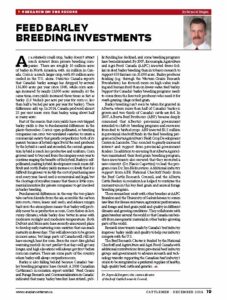Feed Barley Breeding Investments
This article written by Dr. Reynold Bergen, BCRC Science Director, originally appeared in the December 2014 issue of Canadian Cattlemen magazine and is reprinted on the BCRC Blog with permission of the publisher.
Remarque : cette page web n’est actuellement disponible qu’en anglais.

As a relatively small crop, barley doesn’t attract much interest from private breeding companies. There are roughly 10 million acres of barley in North America, with six million in Canada. Corn is a much larger crop, with 80 million acres seeded in the U.S. alone. Statistics Canada reports that Canada’s barley acreage has dropped by around 116,000 acres per year since 1980, while corn acreage increased by nearly 23,000 acres annually. At the same time, corn yields increased three times as fast as barley (1.8 bushels per acre per year for corn vs. less than half a bushel per acre per year for barley). These differences add up. In 2014, Canada produced almost 25% more corn than barley, using about half as many acres.
Part of the reason that corn yields have outstripped barley yields is due to fundamental differences in the plants themselves. Corn is open-pollinated, so breeding companies can cross two unrelated varieties to create a commercial variety that greatly outperforms both of its parents because of hybrid vigor. But if the seed produced by the hybrid is saved and re-seeded, the second generation hybrid is much less productive and uniform. Corn growers need to buy seed from the company every year to continue reaping the benefits of the hybrid. Barley is self-pollinated, making hybrid development much more difficult and costly. Barley yields increase so slowly that it is difficult for growers to justify the cost of purchasing new seed every year. Saved seed is economical and legal, but the shortage of royalties means that there is little commercial incentive for private companies to get involved in barley breeding.
Fundamental differences in the way the two plants take carbon dioxide from the air, assemble the carbon into roots, stems, leaves and seeds, and release oxygen back into the atmosphere mean that barley will probably never be as productive as corn. Corn thrives in hot, sunny climates, while barley does better in areas with moderate sunlight and moderate temperatures. Both DuPont and Monsanto have recently announced plans to develop early-maturing corn varieties that can reach maturity in fewer days. This will allow corn to be grown in more areas, but large parts of Canada will still not have enough heat for corn. Even the most dire global warming models do not predict that days will get any longer, and high elevations will always get frost before corn can mature. There are some parts of the country where barley will always outperform corn.
Barley is also falling behind because Canada’s barley breeding programs have shrunk. A 2008 Canadian Cattlemen’s Association report entitled “Feed Grains and Forage Research and Commercialization in Canada” indicated that many barley breeders have retired, public funding has declined, and some breeding programs have been eliminated. By 2007, for example, Agriculture and Agri-Food Canada (AAFC) invested fewer dollars in feed barley breeding than in tobacco research to support 650 farmers on 35,000 acres. Barley producer funding (e.g. through the Western Grains Research Foundation) has focused more on high value malting and human food than on lower value feed barley. Support for Canada’s barley breeding programs needs to come from the livestock producers who need it for swath grazing, silage or feed grain.
Barley breeding can’t even be taken for granted in Alberta, where more than half of Canada’s barley is grown and two thirds of Canada’s cattle are fed. In 2007, Alberta Beef Producers (ABP) became deeply concerned that Alberta’s provincial government intended to shift its breeding programs and resources from feed to biofuel crops. ABP invested $1.5 million in provincial check-off funds in the feed breeding program at Alberta Agriculture’s Field Crop Development Center in Lacombe. This soon led to greatly increased interest and support from provincial government funders. In addition to ensuring that Alberta Agriculture maintained their feed grain breeding program, these investments also ensured that they recruited a new scientist (Dr. Flavio Capettini) to lead the program once Dr. Jim Helm retires. Additional industry support from ABP, National Check-off funds from the Beef Cattle Research Council, and the Alberta Cattle Feeders Association has helped to continue the momentum in this key feed grain and annual forage breeding program.
These researchers work with other breeders at AAFC Brandon and the University of Saskatchewan to screen new lines for disease resistance, agronomic performance and forage and feed grain yield and quality in different climates and growing conditions. They collaborate with grain breeders around the world so that Canada can benefit from new genetic material in other barley-growing parts of the world.
Research investments made by Canada’s beef industry improves barley yields and quality to help our industry compete with the US.
Click here to subscribe to the BCRC Blog and receive email notifications when new content is posted.
The sharing or reprinting of BCRC Blog articles is typically welcome and encouraged, however this article requires permission of the original publisher.
We welcome your questions, comments and suggestions. Contact us directly or generate public discussion by posting your thoughts below.